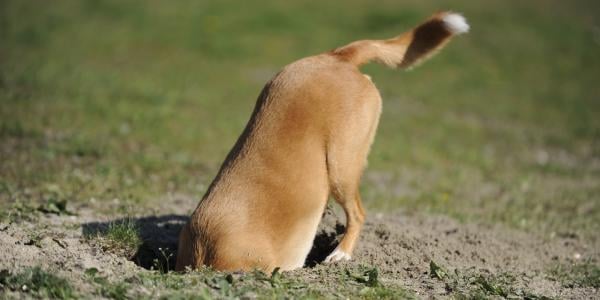 Have you ever stepped outside to find your once-pristine yard transformed into a lunar landscape of holes? If your dog is digging, it can be quite frustrating.
Have you ever stepped outside to find your once-pristine yard transformed into a lunar landscape of holes? If your dog is digging, it can be quite frustrating.
Ever since moving to a home with a larger yard, I've noticed my older dog has started digging more. My younger dog watches carefully as she digs and I think he's taking notes on the most effective techniques.
While I don't mind their digging because it's in places that I've "approved" for digging (easy to fill in regularly and not near a fenceline), I know that many people struggle to keep their dog's digging habit under control.
Your dog may be digging for a variety of reasons, all of which are natural dog behaviors. Knowing why they are digging will make stopping the digging easier. Let's look at the causes of digging and then dive into how to stop your dog's digging in your yard.
Table of Contents
Why Is Your Dog Digging?
To make sure that your efforts to stop your dog's digging are targeted and effective, identify why your dog is digging from the list below. Then check out the steps to stop the digging based on each underlying reason in the next section.
Digging Due to Boredom
Many dogs are stuck with no job to do in their modern homes. And when your dog gets bored, they'll often seek out an activity to relieve their boredom and burn excess energy. Digging is a favorite go-to for many dogs, especially those that are left unsupervised outdoors.
Digging can also happen as part of a pent-up energy release, such as when dogs get the zoomies — they may even run, stop to frantically dig, start running again, and so on. This can happen after they've been cooped up all day, or simply when they get excited about something, like when visitors come over or after a bath.
Digging to Cool Off
On warm days, dogs will seek out cool places to rest. Dogs don't sweat to cool off like humans do. Instead, they pant. But panting might not be enough on hot days. Dogs resort to digging as a natural cooling mechanism, seeking solace in the coolness of the earth beneath the surface.
Digging to Escape
Digging underneath a fence is an easy way to gain freedom from a yard, and some dogs are quick to figure this out. A dog may simply want to explore or see something interesting (squirrel!) and want to follow. There may be another dog in their yard on the other side of the fence.
Some dog breeds are more prone to wandering tendencies. Breeds that are independent or have a high prey drive are likely to seek a way out of a yard, such as Siberian Huskies or any scent hound.
Digging under the fence can be very dangerous for your dog, so it's important to address it as quickly as possible.
Digging to Find Prey
Every time my older dog comes across a molehill on a walk, she begins to frantically dig. Dogs are attracted to finding and catching prey. While domesticated dogs may not rely on hunting for survival, their instincts to chase and catch prey remain deeply ingrained. If they hear or smell a rodent, rabbit, or insect underground, they'll often dig to try and catch it. This is especially true of dog breeds historically used to hunt vermin, such as terriers or Dachshunds.
Digging to 'Cache' Items
Some dogs will want to save their precious chews for later and may dig a hole to hide them in. In the wild, dogs and their ancestors would often bury excess food or prized possessions as a way to secure resources for times when food was scarce. This behavior allowed them to create hidden reserves of food, bones, or other valuable items that they could retrieve later.
Caching food or chews may also be a way of marking their territory. By burying objects, they leave behind their scent, which acts as a territorial marker and communicates to other animals that the area is claimed.
Some dogs may dig and bury items simply because they find them valuable or enjoyable to possess. This can be a form of hoarding behavior, where they stash away cherished toys, treats, or even items that have a strong scent, such as clothing or shoes that carry their owner's scent.
We don't want our dogs burying food items in the yard, as this can attract wildlife and other pests.
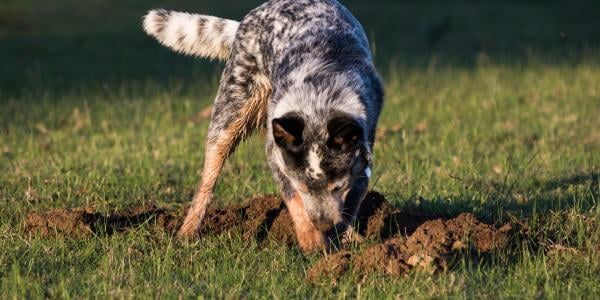
How to Stop Your Dog's Digging in the Yard
Once you've determined the reason why your dog is digging, you'll be able to effectively address their digging. Because digging is a normal, natural dog behavior, it's important to first implement management. This means making changes to your dog's routine, access, or environmental setup to prevent inappropriate digging in the first place.
Health Note: If your dog is a digger, it's a good idea to monitor their poop! Some diggers eat dirt and become constipated. You'll also want to make sure to have regular fecal examinations and deworming done as there is an increased chance of getting intestinal parasites.
Block Off Places Where You Don't Want Your Dog to Dig
If you have flowers or vegetables that you want to protect from any digging, create clear boundaries using decorative fencing, rocks, or raised planters. This helps visually distinguish these areas and discourages your dog from venturing into them. For determined diggers, you may need to install more permanent and taller fencing around these areas in your yard.
In extreme cases, you can make the off-limits areas less appealing to your dog with pet-safe deterrents. Things like citrus peels, vinegar, or repellant sprays with scents that dogs dislike, such as Nature's Miracle Pet Block. Apply these substances to the edges or surfaces of the areas you want to protect.
I recommend this as only your last option, as often, when we address the underlying cause of digging, using a deterrent isn't necessary. And some dogs do not care if there are sprays or other deterrents, especially if they are after prey underground.
Do not use deterrents that can irritate your dog's eyes, nose, or mouth, such as hot sauce, chili pepper, cayenne pepper, horseradish oil, mustard oil, or ammonia.
Don't Leave Your Dog Unsupervised Outside
The number one way to stop digging is to watch your dog when they are outside in your yard or garden. Don't leave them out there alone and expect them to not engage in normal dog behaviors like digging (or barking). This is especially important for dogs who dig to try and escape.
Accompanying your dog in the yard not only means you're there to interrupt and redirect them if they start to dig, but it also means you can ensure they do their potty business, and you get some much-needed outdoor time too. It's a perfect chance to build your relationship and practice some recall, play a quick game of fetch, or get out the flirt pole to burn excess energy.
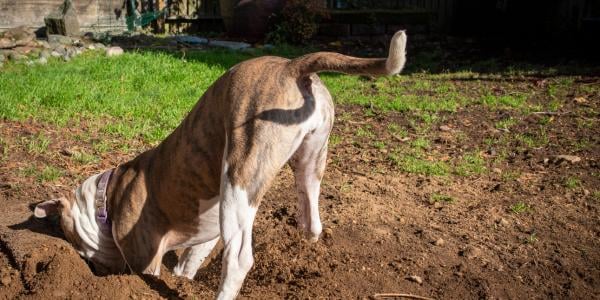
Boredom Fix: Build Your Dog a Dig Pit
Since digging is a natural dog behavior, it's important that we meet our dog's needs and provide them with an outlet for digging! In order to save your garden and reduce your frustration, build a dig pit for your dog where they are allowed to dig to their heart's content.
- Use a kiddie pool or sandpit container and fill it with kid-safe sand or dirt.
- Designate a specific corner or area of your yard that's okay to dig in. Mark it with small garden dividers to help your dog learn where it's okay to dig.
- Build a raised garden bed filled with dirt or sand.
- When not in use, it's a good idea to securely cover the dig pit to prevent wildlife from checking it out. Do not let children play in your dog's dig pit. Here's a video showing how to build a dig pit:
How to Introduce a Dig Pit to Your Dog
- Bury some of your dog's toys, treats, or chews in their designated area. Make it easy at first, leaving the toy partially uncovered before burying it completely.
- Explore the dig pit with your dog, getting involved in helping them uncover their buried treasure and getting excited with them when they unbury things.
- If your dog goes to inappropriate areas and starts to dig, simply redirect them back to their special area. Then consider blocking off their access to the other areas to prevent digging in the wrong spot. See below how to interrupt their digging.
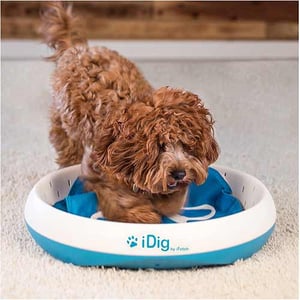
If you are looking for an indoor option for digging (especially useful during rainy weather or cold months), there are a couple of options:
- Set up a small kiddie pool and fill it with blankets and towels. Then bury toys, treats, and chews and encourage your dog to dig through the material to find them.
- Check out the iDig Stay digging toy. I tried this with my dogs, and they enjoyed not only digging at the material but also snuffling around with their noses.
Boredom Fix: Increase Exercise and Enrichment
Digging may not be your dog's favorite thing to do, but if that's all that is available to them when out in the yard then it's likely they'll start digging to relieve boredom. Make sure your dog is getting enough physical exercise and mental enrichment each day.
Your dog's exercise needs depend on their age, health, weight, breed, and size. A good rule of thumb is at least 30 minutes of exercise each day, but some dogs need much more than this! Ask your veterinarian how much your dog needs. It's not just about a daily walk either — playing games of fetch, flirt pole chasing, and other physical movement is important too.
Beyond physical exercise, your dog's brain needs stimulation! Provide your dog with daily enrichment activities, such as feeding from an interactive food puzzle or going on sniffari. Changing up different enrichment activities helps prevent boredom and burns excess energy for your dog. It's amazing to see how much enrichment prevents undesirable behaviors like inappropriate digging.
Get more ideas for dog enrichment here and check out my Top 10 Boredom Busters for Dogs.
Cooling Off Fix: Provide Cool Resting Areas for Your Dog
It's essential that your dog has somewhere cool to rest when it's warm outside. Heatstroke can be deadly.
The best way to keep your dog from digging on hot days is to keep them inside where it's cool with fans or air conditioning. But if you're all wanting to spend time outside on a nice day, then create cooling-off opportunities that don't require any digging. This could be a kiddie pool filled with water, a sprinkler running, or putting out cooling mats. Set up umbrellas or other shade for your dog to rest under. And always make sure your dog has plenty of fresh water to drink.
Find more tips for Keeping Your Dog Cool in the Summer here.
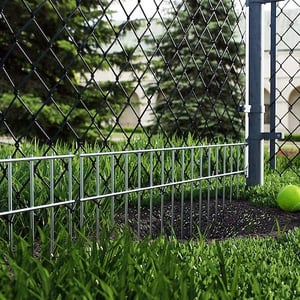 Escape Fix: Secure Your Fenceline
Escape Fix: Secure Your Fenceline
If your dog is digging under your fence, you'll need to secure the perimeter underground. First, walk the entire perimeter of your fence line to make note of everywhere your dog has shown interest in digging. Some dogs are equal opportunity diggers all along the fence.
Others have particular places where digging is more likely to happen – where there's already a wider gap or where the fence is shared with another dog's yard. Other wildlife may also be digging under your fence, making it easy for your dog to join in.
Install an in-ground barrier, like the Dig Defence No-Dig Animal Barrier. If your dog has started digging at various points along the fence, then it's best to install an in-ground fence barrier along the entire perimeter.
However, if they tend to gravitate toward only a few places in particular, you may be able to just install some barriers in those places. Once you have a barrier installed, check the fence regularly to see if your dog is trying to dig in other locations or trying to dig deeper below the barrier.
Prey Drive Fix: Address Rodents in Your Yard
If you have moles or other rodents residing in your yard, to stop your dog's digging, you'll want to address the rodents. Once you remove the prey, there is no reason to dig in an effort to hunt.
Learn about Pet-Safe Rodent Traps and Baits here. Some Preventive Vet team members have used solar-powered mole deterrent spikes. They're better than the battery-powered ones because you could have a major safety issue if your dog chews the spike and chews or ingests the batteries.
Prey Drive Fix: Get Involved With Earthdog
If your dog just loves to dig to try and catch a mole or rabbit, channel that energy into the fun dog sport of Earthdog. While terriers excel at this sport because they were bred to hunt underground, any dog can participate if they enjoy it. Learn more about getting started in Earthdog here.
Caching Fix: Monitor Your Dog's Chewing
If your dog buries their bones or chews in the yard, you'll need to monitor them when you give them these items. This way you can prevent them from needing to bury them for later in the first place. Don't let your dog take their chews outside with them. If they are done chewing, then trade the chew for a treat and then throw it away or save it for later.
My older dog shows a caching tendency with her chews. She's always done this behavior with her chews, but more so now that there is a second dog in the home. To prevent her from burying them in the yard, she's only allowed to have them inside. And when she's done chewing but walking around whining (looking for somewhere to hide it), I help her out and hide it for her. Here's a video of this caching routine we have:
What to Do If You Catch Your Dog Digging in the Yard
Interrupt and Redirect Inappropriate Digging
If you are in the yard with your dog and they start to dig, calmly interrupt them. You can do this by moving towards them and calling their name, or calling them to you. Direct them to an appropriate activity instead of digging.
If they have a dig pit, take them there and encourage digging. If they do not have a dig pit, you can go back inside with them or, if you want to stay outside, then engage in an activity with them to distract them from the digging opportunity.
Teach your dog the basic obedience skill "Leave It," and consistently reinforce this when they approach or show interest in forbidden-to-dig areas. Reward them with praise, treats, or playtime when they respond.
There is no point in getting angry at your dog or punishing them for digging. Getting angry will only increase your frustration and damage the relationship between you and your dog. It won't stop the digging.
Digging is an instinctive behavior, and your dog is just doing what they are "programmed" to do. It's up to you to manage the environment so they can't practice digging where you don't want, provide alternative and appropriate opportunities for this behavior if needed, and meet their exercise and enrichment needs in other ways.
Is your dog digging in your yard? Let us know if you have questions about dog digging in the comments below.



